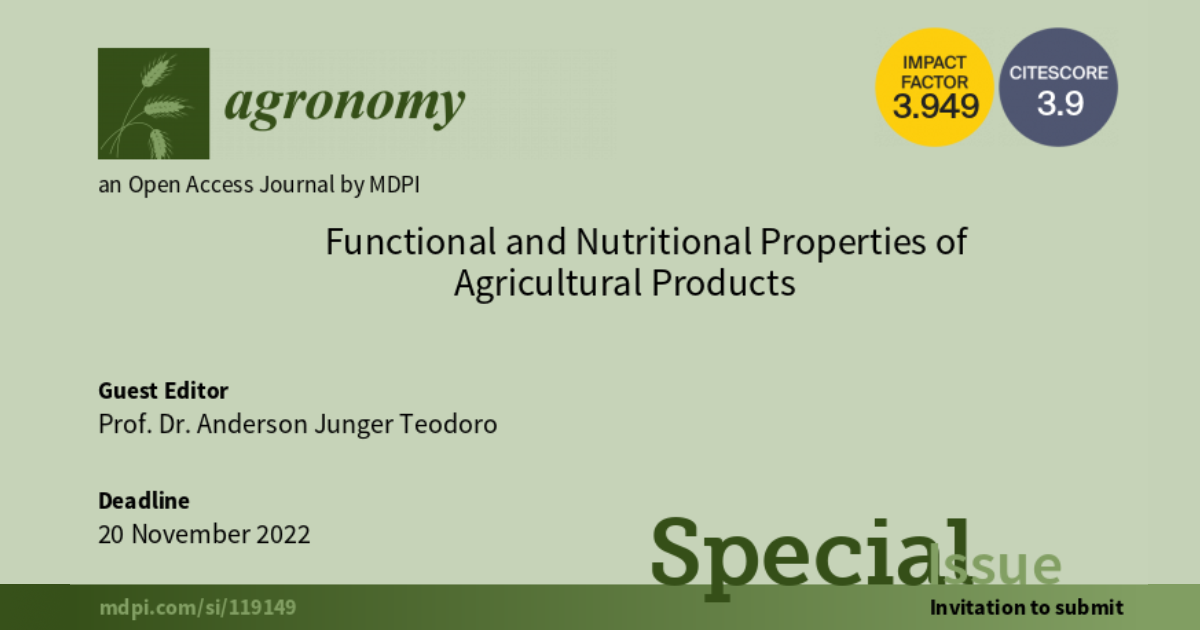Functional and Nutritional Properties of Agricultural Products
A special issue of Agronomy (ISSN 2073-4395). This special issue belongs to the section "Agricultural Biosystem and Biological Engineering".
Deadline for manuscript submissions: closed (30 September 2022) | Viewed by 14040

Special Issue Editor
Interests: bioactive compounds; functional foods; cancer; food development; carotenoids; phenolic compounds
Special Issues, Collections and Topics in MDPI journals
Special Issue Information
Dear Colleagues,
Agricultural products are the basis of nutrition and support the normal metabolism against different pathologies. The nutritional value and functional properties of agricultural products are mainly related to foods rich in active ingredients that contribute to maintaining good health. The nutritional properties and the active principles obtained from agricultural products can play an important role in the body by performing various health and metabolic functions.
This Special Issue encourages the submission of high-quality research articles and reviews covering recent advances in the nutritional and functional characterization of agricultural products and derived compounds used in healthy foods.
Potential topics for this Special Issue include, but are not limited to, the following:
- Production of agricultural foods with high nutritional and functional potential;
- Influence of processing technologies on nutritional and functional properties of agricultural foods;
- Bioactive compounds with functional roles derived from agricultural products;
- Extraction, identification, and quantification techniques for bioactive compounds derived from agricultural products;
- Methods for supplementing foods with bio-compounds derived from agricultural products;
- Relationship between the bioactive compounds of agricultural products and health.
Prof. Dr. Anderson Junger Teodoro
Guest Editor
Manuscript Submission Information
Manuscripts should be submitted online at www.mdpi.com by registering and logging in to this website. Once you are registered, click here to go to the submission form. Manuscripts can be submitted until the deadline. All submissions that pass pre-check are peer-reviewed. Accepted papers will be published continuously in the journal (as soon as accepted) and will be listed together on the special issue website. Research articles, review articles as well as short communications are invited. For planned papers, a title and short abstract (about 100 words) can be sent to the Editorial Office for announcement on this website.
Submitted manuscripts should not have been published previously, nor be under consideration for publication elsewhere (except conference proceedings papers). All manuscripts are thoroughly refereed through a single-blind peer-review process. A guide for authors and other relevant information for submission of manuscripts is available on the Instructions for Authors page. Agronomy is an international peer-reviewed open access monthly journal published by MDPI.
Please visit the Instructions for Authors page before submitting a manuscript. The Article Processing Charge (APC) for publication in this open access journal is 2600 CHF (Swiss Francs). Submitted papers should be well formatted and use good English. Authors may use MDPI's English editing service prior to publication or during author revisions.
Keywords
- bioactive compounds
- food technology
- functional foods
Benefits of Publishing in a Special Issue
- Ease of navigation: Grouping papers by topic helps scholars navigate broad scope journals more efficiently.
- Greater discoverability: Special Issues support the reach and impact of scientific research. Articles in Special Issues are more discoverable and cited more frequently.
- Expansion of research network: Special Issues facilitate connections among authors, fostering scientific collaborations.
- External promotion: Articles in Special Issues are often promoted through the journal's social media, increasing their visibility.
- Reprint: MDPI Books provides the opportunity to republish successful Special Issues in book format, both online and in print.
Further information on MDPI's Special Issue policies can be found here.





